
Table 1: Knowledge and Awareness of Common Medical conditions and Oral Manifestations

Gillam JL*1 Williams A1 Gillam DG2
1Homerton University Hospital Foundation Trust, London UK*Corresponding author: Dr. David Gillam, Barts and the London School of Medicine and Dentistry, QMUL, London UK, E-mail: d.g.gillam@qmul.ac.uk
Aims: The aim of the present study was to raise nursing staff knowledge and awareness by way of a teaching session together with a questionnaire assessment.
Methods: Trained and untrained nurses were asked to complete a questionnaire on oral care, prior to and following a teaching session to determine whether there was an awareness and understanding of common medical problems with recognised oral manifestations in patients under their care.
Results: 46 nurses (31 trained; 15 untrained) completed the first questionnaire prior to the teaching session, 41 nurses (28 trained; 13 untrained) completed the second questionnaire following the teaching session. Data from the two questionnaires were compared and analysed using SPSS. Overall the results demonstrated a generalised lack of awareness in the core knowledge concerning oral care. The results highlighted areas of confusion in recognising the appropriate medication to be used for specific oral conditions as well as their potential side effects in the mouth. Most nurses were unaware of the most appropriate tools available to assess oral care on the wards. Comparison of responses from the two questionnaires indicated a marked improvement following the teaching session.
Conclusions: The introduction of a questionnaire and teaching session on oral care knowledge and awareness revealed an interesting insight into nursing staff awareness and attitude to oral care on the wards. The results highlighted the importance of updating oral care teaching for nurses on the wards, which would enable nurses to provide a higher standard of oral care to patients.
Assessment tools; Oral (Mouth) care; Questionnaire; Core knowledge; Essence of care
There appears to be limited data on nurse awareness of the importance of oral care in hospitals. Anecdotal evidence would also suggest that oral care is not practiced in a consistent manner, which in turn may lead to inadequate or inappropriate care on the wards. From a review of the available literature up to mid/late1990s that was pertinent to the present study, there was clear evidence of a lack of adequate training in the assessment and implementation of mouth care by nurses [1-9]. For example, a review into nursing training indicated that 72% of nurse training colleges fail to teach any written oral assessment methods, furthermore most nursing text books (27 out of 31) also failed to mention this important subject and in her review of 31 articles form 14 Nursing Journals 18 (58%) articles mentioned the lack of any updated knowledge of mouth care given to nursing staff [5]. Boyle [2] and O’Dowd [10] also expressed concern regarding the lack of clear guidelines and inadequate training given to nurses on the subject of oral care and generally the task of implementation of oral care on the ward is often delegated to the junior staff [11]. Furthermore the lack of a basic knowledge of oral care relating to a healthy mouth may have implications for Nurses to carry out a proper assessment which in turn may compromise the quality of patient care [12]. However it should be recognised that Longhurst’s review is now seven years old and there have been a number of textbooks published since 1998 [13-19] that have addressed some of the issues raised by Longhurst [5]. Furthermore the publication of the Department of Health benchmarking document ‘The Essence of Care 2001’ (with an extensive section on Personal and oral hygiene) together with the publication of various guidelines from the British Society for Disability and Oral Health [20-25] have also addressed the apparent shortcomings of the assessment and implementation of oral care on the ward. A recent study by Hijji [12] into trained nurses’ knowledge and practice of oral care on the ward however still gives some concern about the implementation of good practice to patients, although implementation of an intensive staff training programme on oral care in a long-term care institute was reported to be effective in changing both oral care procedures by staff and an improvement in the oral health of residents [26]. A number of investigators have also linked the importance of the maintenance of the oral cavity to the prevention of major systemic diseases which in turn may have a significant effect on the global burden of health [27-32].
The aim of the present study was to raise nursing staff knowledge and awareness of oral care on the wards by way of a teaching session together with a pre- and post-training questionnaire assessment.
Following approval from the Ethics Committee, trained and untrained nurses1 were asked to complete a questionnaire on oral care, prior to and following a 30 minute teaching session (overheads and handouts illustrating medical conditions with oral manifestations, medication which may affect the oral cavity etc.) to determine whether there was an awareness and understanding of common medical problems with recognised oral manifestations in patients under their care. The purpose of this questionnaire and teaching programme was to raise staff knowledge and awareness in the following areas (Table 1).
For the purpose of the present study a literature search was undertaken to determine which would be the most appropriate oral assessment guide available for use on the wards. A number of assessment tools such as the Oral Assessment Guide (OAG) and modifications of the OAG have been reported to be helpful in the assessment of oral care on the wards [33-39] (Table 2). A criticism of these guides however has been that they are very time consuming to use on a busy ward [40]. The Jenkins Oral Calculator [41] utilised in this study was previously designed to be used in the intensive care setting and includes an ‘at risk’ component in the assessment of oral care needs and therefore it was considered appropriate for use in the study.
Following a review of the published literature [2,3,38,40,42,43] and a subsequent pilot study it was evident that there were areas of concern in the management of oral care as practiced by nurses on the wards. The questionnaire used in the present study attempted to address these concerns as indicated below (Table 3).

Table 1: Knowledge and Awareness of Common Medical conditions and Oral Manifestations

Table 2: Assessment Tools used to assess oral care on the ward
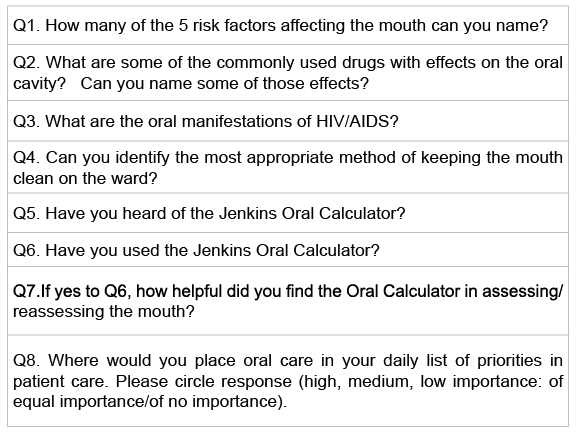
Table 3:Questionnaire use in the study
48 nurses attended one or both of the questionnaires sessions including the teaching session. Due to work commitments a number of nurses were unable to attend both sessions. 46 nurses (31 trained; 15 untrained) therefore completed the first questionnaire prior to the teaching session, 41 nurses (28 trained; 13 untrained) completed the second questionnaire following the teaching session. Data from the two questionnaires were compared and analysed using SPSS. Overall the results demonstrated a generalised lack of awareness in the core knowledge concerning oral care. The results highlighted areas of confusion in recognising the appropriate medication to be used for specific oral conditions as well as their potential side effects in the mouth. Most nurses were unaware of the most appropriate tools available to assess oral care on the wards. Comparison of responses from the two questionnaires indicated a marked improvement following the teaching session (Figures 1-3, Tables 4-7).
There appeared to be some confusion with what nurses considered to be a risk factor and it was evident as a consequence of this, that there was a lack of knowledge and understanding about the type of risk factors reported in the published nursing literature (HIV/AIDS, smoking, drugs [medication], chemotherapy/radiotherapy, ageing, diabetes) that may affect the mouth. Comparison of the total response from both questionnaires indicated that there was an increased response rate per nurse to Q1 following the teaching session (Figure 1).
There was evidence of a lack of knowledge and understanding about the type of drugs used and their effects on the oral cavity. This was particularly true with the untrained staff. The effects of medication on the oral cavity, was poorly answered (Figure 2) and known effects caused by medication (e.g., Antihistamines, antispasmodics, cancer-chemotherapy drugs, decongestants, and muscle relaxants) such as dryness of the mouth, reduction in salivary flow, gingival hyperplasia (swollen gums), disturbed taste and discolouration of the teeth were not readily known. Comparison of total responses of all nurses however indicated that there was an increased response rate per nurse to Q2 following the teaching session. Of the responses recorded Candida (thrush) was highlighted as a major side effect of medications (antibiotics, steroids etc). Ulcers and soreness were also recognised as side effects of some of these therapies (Table 4).
Candida (thrush was the condition most identified by nurses, other recognised features of HIV (Hairy leucoplakia, Kaposi’ Sarcoma, Herpes, HIV Gingivitis, HIV Periodontitis, atypical ulceration and salivary gland disease) however, were not readily recognised by all staff prior to the teaching session, although it is acknowledged that these features may be of a more specialised nature and input from other members of the multidisciplinary team may be required. Following the teaching session there was a marked awareness of oral manifestations of HIV/AIDS. Comparison of total responses of all staff indicated that there was an increased response rate per nurse to Q3 following the teaching session (Figure 3).
The response to this question identified some confusion among nurses prior to the teaching session. Comparison of total responses of all nurses indicated that there was an increased response rate per nurse to Q4. Tooth brushing was considered the most appropriate method of oral care on the ward (Table 5).
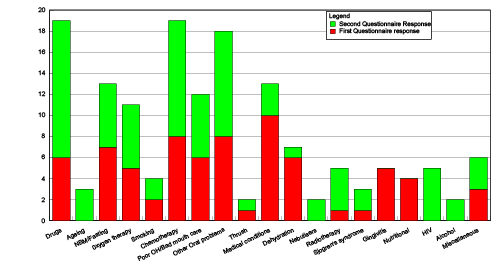
Figure 1 Q1: Name any risk factors affecting the mouth (Total Responses)
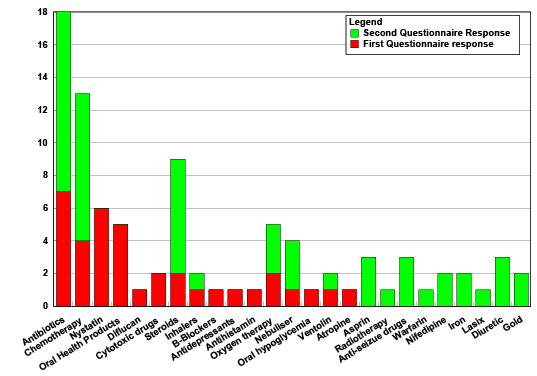
Figure 2 Q2: Name some of the commonly used drugs that might affect the mouth (Total Responses)
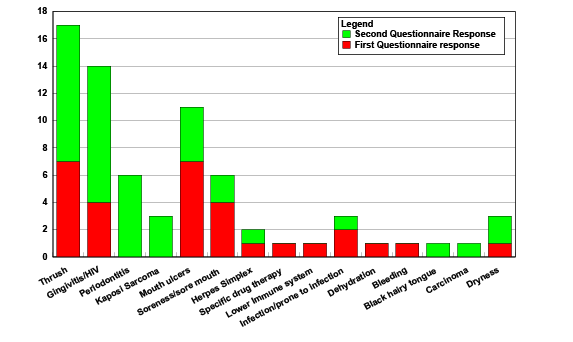
Figure 3 Q: Conditions associated with HIV/AIDS (Total Responses)
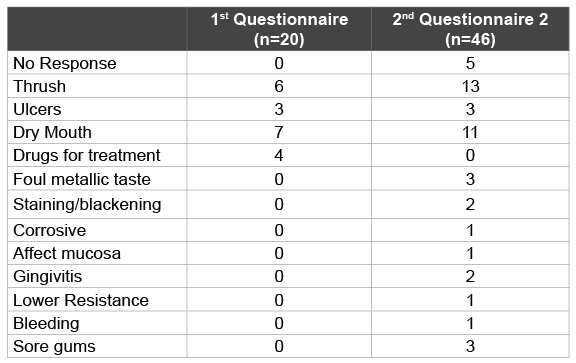
Table Q4: Response to Question 2 Effects of Medication on the mouth (Total Responses)
This question identified an area for concern. Most nurses were not aware of the Jenkins Oral Calculator prior to the teaching session and it was evident that it was not used routinely on the wards. Following the teaching session there was a greater awareness of the Calculator among nurses as well as some evidence that it had been implemented on the wards. Several nurses commented that they found the Calculator to be beneficial on the ward. When answering Q5 (1st Questionnaire (n=46)] only 8 (17.4%) nurses said they had heard of the Jenkins Oral Calculator, 38 (82.6%) had not. Following completion of the 2nd questionnaire (n=41), 38 (92.7%) nurses said that they were aware of the assessment tool (following the 1st Q) and 3 (7.3%) said they had not been aware of the tool. When answering Q6 regarding whether nurses used the Jenkins Oral Calculator on the wards the responses indicated that when completing the first Questionnaire (n=46), only 2 (4.3%) nurses said they used the questionnaire, 44 (95.7%) had not. Following completion of the 2nd questionnaire, 11 (26.8%) nurses said that they used it on the ward (following the 1st Q) and 30 (73.2%) said they had not. When answering Q7 regarding the usefulness of the Jenkins Oral Calculator on the ward it was evident that from the results of Q5 that most nurses had not heard of this particular assessment tool. Consequently in answering the first Questionnaire all nurses (n=46) (100%) said they had not found the assessment tool helpful. Following completion of the 2nd questionnaire (n=41), 28 (68.3%) nurses gave no response. Of those 13 (31.7%) nurses who had used the assessment tool (following the 1st Q) stated that they either found it helpful (n=5), very helpful (n=1), good (n=2), fair (n=2), ok (n=1) to use and 2 found it either difficult to assess the tool or were unable to comment.
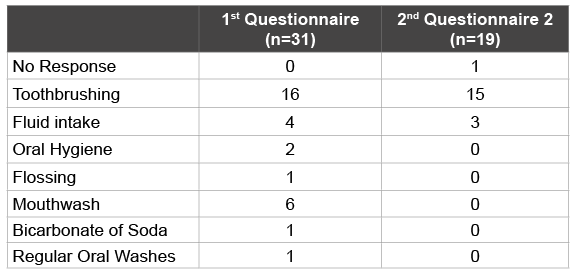
Table 5 Q4: : Identify the most appropriate method of keeping the mouth clean on the ward. (Total responses)
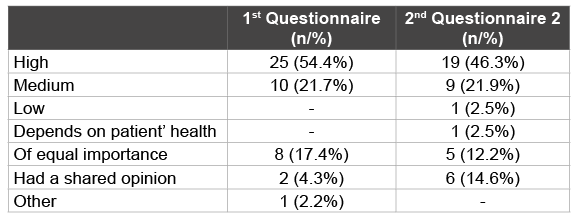
Table 6 Q8: How important is Oral Care? (Total Responses)
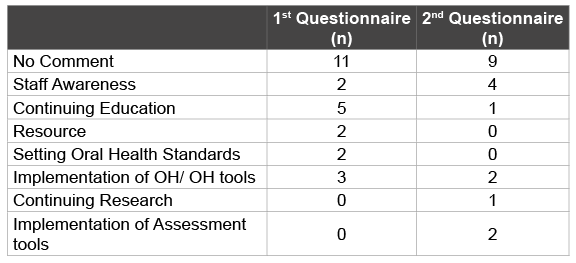
Table 7 Q8: How important is Oral Care? Additional Comments (Total Responses)
Most nurses claimed to have placed oral care as a high or medium priority on the ward but the reality was that when the wards were busy oral care appeared to be relegated to a lower level of priority. Supplementary comments made by nursing staff were also recorded and analysed (Tables 6-7).
A number of investigators have linked the importance of the maintenance of the oral cavity to the prevention of major systemic diseases which in turn may have a significant effect on the global burden of health [27-32]. For example, according to Petersen et al. [29] and Marcenes et al. [31] oral diseases, such as dental caries, periodontal disease, tooth loss, oral mucosal lesions and oropharyngeal cancers, human immunodeficiency virus/ acquired immunodeficiency syndrome (HIV/AIDS)-related oral disease and oro-dental trauma are major public health problems which have a major global burden in terms of health and economic costs to society. Furthermore, poor oral health (in particular periodontal diseases) may have a profound effect on general health and quality of life, and several oral diseases have been reported to be related to chronic diseases (e.g. diabetes, smoking, obesity) [27-32]. The identification of the risk factors associated with poor oral health (in particular periodontal diseases) are therefore, paramount for the prevention of system conditions that may have a major health burden on individuals in society. It is evident from these studies of the risk posed to the population at large if oral health is not adequately maintained by individuals during their daily routine. Therefore, it stands to reason that when individuals are unwell and require hospital admission that nurses and other healthcare professionals should be aware of the need to adequately manage good oral health procedures in order to prevent any further deterioration of the individual’s general health.
The questionnaire used in the present study was based on findings from a review of the published literature [2,3,38,40,42,43]. A small pilot study was subsequently conducted to determine its suitability in evaluating the nursing staff ’s knowledge and awareness of oral manifestations with common medical conditions (and medication) in the management of oral care on the ward. The results of this pilot study were presented to the Hugh James Galbraith committee (JLG/AW) and any recommendations were implemented into the questionnaire used in the present study.
While it is recognized that responsibility for the provision of oral care in hospitals usually falls to the nursing staff particularly the more junior staff [11], it is a matter of concern that according to Miller and Rubinstein [1] recently qualified nurses do not have the necessary insight to assess a patient’s oral care status. Furthermore the lack of a basic knowledge of oral care relating to a healthy mouth may have implications for Nurses to carry out a proper assessment which in turn may compromise the quality of patient care [9,12]. According to Hijji [12] this may be as a result of inadequate educational input during basic training, variations in regional training or the lack of regular updating post training. In order to alleviate some of these concerns it is important to have some involvement of professional dental staff in the educational programme for student nurses and deriving good mouth care protocols, advising on management of difficult oral problems and providing appropriate treatment which would in turn provide comprehensive care for patients on the ward [4]. One of the authors in the present study was a qualified Dentist (DGG) who provided the relevant dental information and who advised the other two authors who were practising nurses (JLG/AW) on the relevant oral conditions and medications which may affect the mouth.
Prior to the commencement of the present study a number of assessment tools such as the Oral Assessment Guide (OAG) and modifications of the OAG which had been reported as being helpful in the assessment of oral care in the hospital/hospice environment were reviewed [33-39] (Table 2). A number of investigators however reported some concern with these assessment tools particularly with regard to reliability and validity [44] and ease of use and length of time taken to assess on a busy ward [40]. In the study by Holmes and Mountain [44] three oral assessment guides were evaluated [34,36,37]. None of the OAGs evaluated proved to be entirely satisfactory for use in either clinical practice or future research, although the authors reported that both the ‘Expert panel’ and ‘observers’ preferred the Eilers et al. OAG and recommended its use until a more appropriate assessment tool becomes available. For the purpose of this present study it was decided to utilise the Jenkins Oral Calculator [41] which had been previously used in the intensive care setting and included an at risk component in the assessment of oral care needs and was reported to be well received by nurses when evaluated in a study by Hatton-Smith [40] and in the present study, although it should be recognised that the Jenkins Oral calculator does reply on the subjective interpretations of its user when assessing patients (11]. Further research however is needed to determine which is one of the oral assessment guides would be appropriate in assessing oral care on a busy ward and whether the Jenkins Oral Calculator would be more beneficial than the other recognised assessment tools. According to Evans [11] the Jenkins Oral Calculator still needs to be evaluated in the general ward environment.
Following the completion of the study it would appear from the results that there was a generalised lack of core knowledge concerning oral care as well as a lack of basic awareness of conditions and medications that may affect the mouth (Figures 1-3, Tables 4-5). During the 30 minute teaching session where overheads and handouts illustrating medical conditions with oral manifestations, medication which may affect the oral cavity were presented, it was clear from the responses that there were a number of medical conditions and subsequent effects of the prescribed medication on the oral cavity that the nurses were unaware of. In fairness, however to the nurses participating in the present study it was recognised that this specialised information may not have been readily known by some of the participants. This may be an area where the expertise of the local Multidisciplinary team may be of benefit in updating nurses on the conditions and medications that may affect the mouth. It was also evident from some of responses from the Questionnaire(s) that there were areas of concern in the assessment and delivery of oral care as practiced by nurses on the wards. For example there was no evidence of the regular use of any Oral assessment tools and only a few nurses (8 [17.4%]) said they had heard of the Jenkins Oral Calculator, 38 (82.6%) had not heard of the Jenkins Oral Calculator. The results from our study, appears to substantiate previous claims that there was a lack of adequate training in the assessment and implementation of mouth care by nurses [1-4,8,9,11,12,43,45]. As mentioned earlier the implications for nurses being unable to carry out a proper oral care assessment may compromise the quality of patient care [12]. Perceived barriers to implementing high quality oral care on the ward has also been raised by nurses in several studies [2,12]. These barriers may relate to nurses’ personal dislike of undertaking any oral care on patients [2] to issues of lack of allocated time, understaffing, uncooperative patients or lack of materials and resources [12]. There are also concerns that access for staff training, the use of assessment tools, the implementation of protocols and the provision of oral hygiene materials may vary considerably across the country [46]. According to this recent postal survey based on responses from Senior nurses in a Stroke care setting in Scotland, only a third of the units received any oral care training during the year, although help from Dental professionals was available in most of the units if requested. The use of oral care tools and protocols in the various stroke units however, was limited (approximately 23%). Some of these perceived barriers and concerns were also expressed in our present study and while a number of nurses agreed that oral care should be given a high priority on the ward, the reality may be that when the ward is busy oral care may be relegated to a lower priority (Tables 6-7). Although a number of nurses in our study could not attend both of the sessions, it was encouraging to note that the nursing Sisters where possible (within the constraints of staffing the ward) actively supported the study and enabled the nurses on the respective wards to attend the sessions.
It is apparent that in recent years attempts have been made to implement the teaching of oral care in nursing training as well improving standards of mouth care on the wards. For example, the Essence of Care [47] and the Nursing Best Practice Guideline Shaping the Future of Nursing (RNAO 2008) both deal with providing an extensive assessment, evaluation and implementation of oral care tailored to the needs of the individual patient. Indeed the information contained in this benchmark document appears to address some of the concerns such as assessment tools, involvement of multi-disciplinary teams (dental input) expressed both in the published literature and by the Authors of the present study. It is anticipated that this document will encourage evidence-based practice of oral care and enable nurses to implement best practice on the wards. The results from the present study however, has highlighted the importance of continual professional development in teaching oral care on the ward which in turn would enable nurses to promote a higher standard of quality of care to patients [4]. Furthermore the teaching of oral care including an understanding and awareness of medical conditions and medications that may affect the mouth should be implemented during the basic training of nurses and a structured programme should be designed in cooperation with the Dental profession to provide nurses with an understanding of the importance of oral care in patients under their care in hospital. A recent study by Nicol et al. [18] highlighted the effectiveness of an intensive staff training programme (including lectures and video material, supplemented by clinical demonstrations by Dental professionals) on oral care. The results indicated that there were both improvements in changing oral health care procedures and in the residents’ oral health over the assessment period. Although the present study was a relatively small study, the results did identify deficiencies in the nurses’ core knowledge of oral care as well as highlighting a lack of awareness of conditions and medications that may affect the mouth which may lead in turn to inadequate assessment and practice on the wards, a finding supported by Hijji [12]. Nevertheless an encouraging finding from our study was that there was a marked improvement in correct responses following the teaching session (Figures 1-3, Tables 4-7).
Nurses undoubtedly have an essential role to play in delivering oral care to their patients and it is important that this care is based not on anecdotal unscientific, rarely validated and outdated information [44,45] but rather on the evidence-based practice of oral care that will in turn enable nurses to implement best practice on the wards. Nurses and other healthcare professionals should also be aware of the importance of maintaining good oral care in patients under their care, particularly in the light of the recent systematic reviews and guidelines that clearly indicate that the impact of poor oral health on both general health and the quality of life of individuals [25,27-32).
The introduction of a questionnaire and teaching session on oral care knowledge and awareness for nurses identified deficiencies in their core knowledge of oral care as well as a lack of basic awareness of conditions and medications that may affect the mouth. The results also highlighted the importance of updating oral care teaching for nurses on the wards, which would enable nurses to provide a higher standard of oral care to patients. The importance of implementation of evidence- based oral care protocols on the ward cannot be overlooked if nurses are to provide best practice for their patients. Furthermore, nurses should be aware of the conclusions of recent guidelines and systematic reviews on the importance of maintaining good oral health and the effect of poor oral health on the patient’s general health. For future studies in assessing the quality of oral care on the wards, the criteria recommended in the Essence of Care [48] benchmarking document and the Nursing Best Practice Guideline Shaping the Future of Nursing (RNAO 2008) would be an essential component in any evaluation of oral care on the ward.
The study was supported by a Hugh James Galbraith award. The Authors would like to thank all the nursing staff who participated in the present study and for the co-operation and encouragement given by the Ward Sisters to enable staff to attend the sessions.
Download Provisional PDF Here
Aritcle Type: Research Article
Citation: Gillam JL, Williams A, Gillam DG (2015) Nursing Staff and Oral Care Awareness. Int J Dent Oral Health 2(1): doi http://dx.doi.org/10.16966/2378-7090.162
Copyright: © 2015 Gillam JL, et al. This is an open-access article distributed under the terms of the Creative Commons Attribution License, which permits unrestricted use, distribution, and reproduction in any medium, provided the original author and source are credited.
Publication history:
All Sci Forschen Journals are Open Access